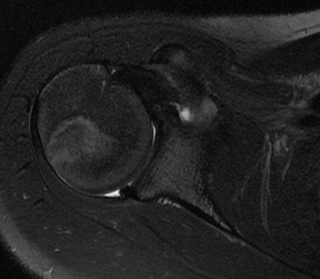Chondrolabral clefts are located in the posterior inferior labrum, according a HSS study. MRI study studies show that are not normal anatomic variants as there are associated with rounded posterior glenoid rims, glenoid dysplasia and future instability.
Schematic preservation of the rounded posterior glenoid rim
Exam under anesthesia and fluoroscopy demonstrated posterior subluxation of the humeral head on the axillary view with the load and shift test.
Anterior directed force with load and shift test shows no dislocation
Posterior subluxation during load and shift test under anesthesia
MRI demonstrates 1. Round posterior glenoid rim 2. Chondrolabral cleft at the posterior inferior glenoid
Rounded posterior rim of the glenoid and chondrolabral cleft on MRI
Exam under anesthesia demonstrated no dislocation with the load and shift test.
6 o ' clock glenoid
Chondrolabral cleft posterior
Arthroscopic load and shift test demonstrated posterior subluxation of the humeral head (+2 on the load and shift test).
Anterior directed force shows no subluxation during load and shift test
Posterior directed force during load and shift test shows posterior subluxation
Capsulolabral repair using three sutures
One suture anteriorly at the bankart area was placed to complete the capsulolabral repair.
Arthroscopic capsulolabral repair was performed at the area of the cleft. An additional suture for reduction of the capsular volume was placed at the Bankart area where the capsulolabral repair was re-enforced. No anchors were used in this case.
It is speculated that the glenoid dysplasia in combination with the loss of the concavity compression and negative suction pressure leads to instability. Closure of the cleft and shoulder joint capsule reduction seems to be an effective method of addressing the problem.
























